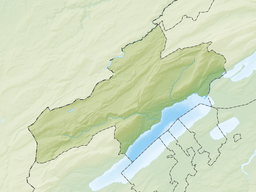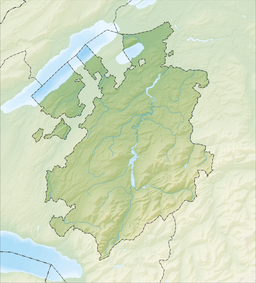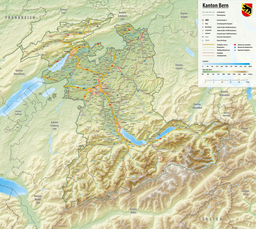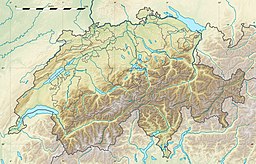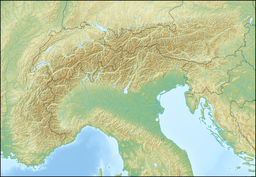Lake Neuchâtel
| Lake Neuchâtel | |
|---|---|
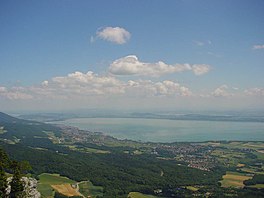 | |
| Coordinates | 46°54′N6°51′E/ 46.900°N 6.850°E |
| Primary inflows | L'Orbe(La Thielle), Le Bey, La Brine, L'Arnon, Ruisseau de la Vaux, Le Vivier, L'Areuse, Le Seyon; Canal Oriental, Le Buron, Ruisseau de l'Epena, La Menthue, Ruisseau de Crêt Moron, Ruisseau de Longefont, Ruisseau de Robin, Ruisseau de la Molliette, Canal de la Broye |
| Primary outflows | Zihlkanal / Canal de la Thielle |
| Catchment area | 2,670 km2(1,030 sq mi) |
| Basincountries | Switzerland |
| Max. length | 38.3 km (23.8 mi) |
| Max. width | 8.2 km (5.1 mi) |
| Surface area | 218.3 km2(84.3 sq mi) |
| Average depth | 64.2 m (211 ft) |
| Max. depth | 152 m (499 ft) |
| Water volume | 13.77 km3(11,160,000 acre⋅ft) |
| Residence time | 8.2 years |
| Surface elevation | 429 m (1,407 ft) |
| Settlements | Neuchâtel,Grandson,Yverdon,Estavayer-le-Lac(seelist) |
 | |
| Official name | Rive sud du lac de Neuchâtel |
| Designated | 9 November 1990 |
| Reference no. | 505[1] |
Lake Neuchâtel(French:Lac de Neuchâtel[lakdənøʃɑtɛl];Arpitan:Lèc de Nôchâtél;German:Neuenburgersee) is alakeprimarily inRomandy,the French-speaking part ofSwitzerland.The lake lies mainly in thecanton of Neuchâtel,but is also shared by the cantons ofVaud,Fribourg,andBern.It comprises one of the lakes in theThree Lakes Region(French:Pays des Trois-Lacs,German:Drei-Seen-Land), along with lakesBiel/Bienne andMorat/Murten.
With a surface of 218.3 km2(84 sq mi), Lake Neuchâtel is the largest lake located entirely in Switzerland and the 59th largest lake in Europe. It is 38.3 km (23.8 mi) long and 8.2 km (5.1 mi) at its widest. Its surface is 429 metres (1,407 ft)above sea level,and the maximum depth is 152 metres (499 ft). The total water volume is 14.0 km3(3.4 cu mi). The lake's drainage area is approximately 2,670 km2(1,031 sq mi) and its culminating point isLe Chasseronat 1,607 metres (5,272 ft).[2]
In comparison to the Lake Geneva region, the Lake Neuchatel shoreline has experienced significant economic development with the completion of the regional motorway network. It is also known to have housed a Celtic agglomeration on pile-dwellings calledLa Tèneand which gives its name to thesecond Iron Age.
The lake is fed by the riversL'Orbe(calledLa ThielleorLa Thièlelocally, downstream of the city of Orbe),L'Arnon,L'Areuse,Le Seyon,andLa Menthue,as well as by theCanal de la Broye.The Thielle Canal (French:Canal de la Thielle,German:Zihlkanal) drains the lake intoLake Bieland is part of regulation system for the lakes and the rivers of theSeelandregion.
Lake Neuchâtel was the home of the nowextinctspecies of deepwater troutSalvelinus neocomensis.[3]
Geography
[edit]Lake Neuchatel is situated at the foot of the Jura mountain range, on the Swiss Plateau. Mainly in the French-speakingSwiss Romande,it borders the territory of four cantons:Neuchâtel(86 km2(33 sq mi)),Vaud(74 km2(29 sq mi)),Fribourg(53 km2(20 sq mi)) andBern(2 km2(0.77 sq mi)).[4]
The lake's main tributaries are theThieleand theBroyecanal which connect it to Lake Morat. It flows into Lake Biel via theThielle canal(German:Zihlkanal).
Since theJura water correctionin the 19th and 20th centuries, it has served, together with Lake Morat, as a compensation basin for the waters of theAareflowing into Lake Biel. Indeed, if the level of the latter rises too much, the flow may stop or even go in the opposite direction.
Lake Neuchâtel is 38 km (24 mi) long and has a maximum width of 8.2 km (5.1 mi). Its maximum depth is 152 m (499 ft) and its capacity is estimated at 14 km3(3.4 cu mi). It is the largest lake located entirely on Swiss territory, considering thatLake GenevaandLake Constanceare shared with neighboring countries.
In the summer of 2021, Lake Neuchatel reached historically high water levels due to widespread flooding over mainland Europe.
History and prehistory
[edit]The lake was frequented byprehistoric manas evidenced by the remains (site of theAuvernierlake resort and archeological museum, theLaténium) where bones ofbrown bearandEurasian beaverwere also found (two species then almost ubiquitous in Europe).[5]Severalmegalithicmonuments line the lake such as thealignment of Clendyand themenhirsofGorgier,Grandson,Saint-Aubin-Sauges,andVauroux,as well as an imposing erratic block, theStone of Marriage.
When the first Swiss towns appear,Mont Vully,which was a large fortified area of around 50hectaresbuilt around 120BCE,controlled the lakes of Morat and Neuchâtel while the La Tène area remained nearly unoccupied. What is nowYverdon-les-Bainswas located on a barrier island on the other side of the lake, a place of smaller settlement (3 to 4 hectares) occupied from the4th century BCE,and later fortified in 80BCEby means of a long and solid rampart with frontal posts (like that of Vully), before thisoppidum(Eburodunum) becomes avicusin the first centuries CE.[6]
The first written mention of the lake dates from the year 998 CE, where alaci everdunensis(or lake of Yverdon, from its Latin nameEburodunum) is mentioned, near which the priory ofBevaixwas founded.[7]The name dominates throughout theMiddle Ages,co-utilized with the current termLake Neuchâtel,however, is frequent from the15th centuryonwards. The latter became dominant during the 19th century, in particular with the lowering of the level of the lake and the development of the Vaudois railway, which reduced the importance of the Port of Yverdon.[7]
Lake Neuchâtel, and in particular the town of Neuchâtel became a popular tourist destination during theBelle Époqueperiod due to its climate and panoramic views of theAlps.
List of settlements on the lake
[edit]Northwestern shore
[edit]
From Yverdon to La Tène (Southwest to Northeast):[2]
- Yverdon-les-Bains(VD)
- Grandson(VD)
- Bonvillars(VD)
- Onnens(VD)
- Corcelles-près-Concise(VD)
- Concise(VD)
- Vaumarcus(NE)
- Sauges (Saint-Aubin-Sauges)(NE)
- Saint-Aubin (Saint-Aubin-Sauges)(NE)
- Gorgier, Chez-Le-Bart (Gorgier)(NE)
- Bevaix(NE)
- Cortaillod(NE)
- Areuse (Boudry)(NE)
- Colombier (Milvignes)(NE)
- Auvernier (Milvignes)(NE)
- Serrières (Neuchâtel)
- Neuchâtel
- Hauterive(NE)
- St-Blaise(NE)
- Marin-Epagnier (La Tène)(NE)
Southeastern shore
[edit]From Yverdon to Gampelen:[2]
- Cheseaux (Cheseaux-Noréaz)(VD)
- Yvonand(VD)
- Cheyres (Cheyres-Châbles)(FR)
- Châbles (Cheyres-Châbles)(FR)
- Font (Estavayer)(FR)
- Estavayer-le-Lac (Estavayer)(FR)
- Forel (Estavayer)(FR)
- Chevroux(VD)
- Pré de Riva (Gletterens)(FR)
- Portalban (Delley-Portalban)(FR)
- Chabrey (Vully-les-Lacs)(VD)
- Champmartin (Cudrefin)(VD)
- Cudrefin(VD)
- La Sauge (Cudrefin)(VD)
- Lindehof, Witzwil (Ins)(BE)
- Tannenhof (Gampelen)(BE)
Notes
[edit]- ^"Rive sud du lac de Neuchâtel".RamsarSites Information Service.Retrieved25 April2018.
- ^abc"Schweiz - Suisse"(Map).Lac de Neuchâtel(2014 ed.). 1:500 000. National Map of Switzerland 1:500'000. Wabern, Switzerland: Federal Office of Topography –swisstopo.ISBN978-3-302-00070-1.Retrieved2017-12-10– via map.geo.admin.ch.
- ^IUCN Red list
- ^"Neuchâtel, lac de".hls-dhs-dss.ch(in French).Retrieved2021-07-22.
- ^Josien, Thérèse (1955)."Station Lacustre d'Auvernier (lac de Neufchâtel). Étude de la Faune de la Station".Bulletin de la Société préhistorique de France.52(1): 57–75.doi:10.3406/bspf.1955.3155.ISSN0037-9514.
- ^Kaenel, Gilbert (2009-03-01)."Archéologie et histoire de la Suisse antique: données récentes".La lettre du Collège de France(25): 16–17.doi:10.4000/lettre-cdf.512.ISSN1628-2329.
- ^ab"Un historien a retrouvé le lac d'Yverdon".24 heures(in French).ISSN1424-4039.Retrieved2021-07-22.
External links
[edit]- .Encyclopædia Britannica.Vol. 19 (11th ed.). 1911. p. 424–425.
- Waterlevels at the Harbour of Neuchâtelfrom the Swiss Federal Office for the Environment

